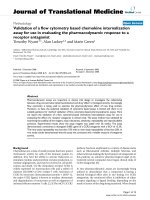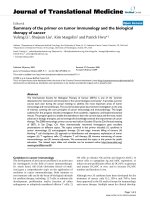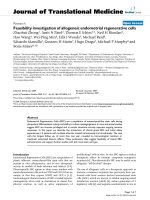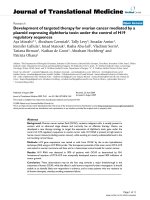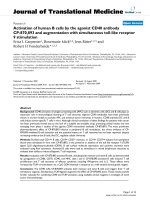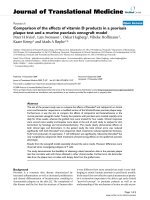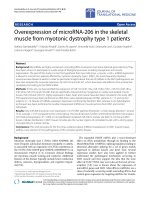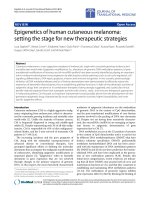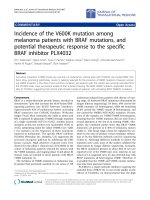Báo cáo hóa học: " Feasibility of the adaptive and automatic presentation of tasks (ADAPT) system for rehabilitation of upper extremity function poststroke" pptx
Bạn đang xem bản rút gọn của tài liệu. Xem và tải ngay bản đầy đủ của tài liệu tại đây (1.15 MB, 12 trang )
RESEARCH Open Access
Feasibility of the adaptive and automatic
presentation of tasks (ADAPT) system for
rehabilitation of upper extremity function post-
stroke
Younggeun Choi
1,2
, James Gordon
1
, Hyeshin Park
1
and Nicolas Schweighofer
1*
Abstract
Background: Current guidelines for rehabilitation of arm and hand function after stroke recommend that motor
training focus on realistic tasks that require reaching and manipulation and engage the patient intensively, actively,
and adaptively. Here, we investigated the feasibility of a novel robotic task-practice system, ADAPT, designed in
accordance with such guidelines. At each trial, ADAPT selects a functional task according to a training schedule
and with difficulty based on previous performance. Once the task is selected, the robot picks up and presents the
corresponding tool, simulates the dynamics of the tasks, and the patient interacts with the tool to perform the
task.
Methods: Five participants with chronic stroke with mild to moderate impairments (> 9 months post-stroke; Fugl-
Meyer arm score 49.2 ± 5.6) practi ced four functional tasks (selected out of six in a pre-test) with ADAPT for about
one and half hour and 144 trials in a pseudo-random schedule of 3-trial blocks per task.
Results: No adverse events occurred and ADAPT successfully presented the six functional tasks without human
intervention for a total of 900 trials. Qualitative analysis of trajectories showed that ADAPT simulated the desired
task dynamics adequately, and participants reported good, although not excellent, task fidelity. During training, the
adaptive difficulty algorithm progressively increased task difficulty leading towards an optimal challenge point
based on performance; difficulty was then continuously adjusted to keep performance around the challenge point.
Furthermore, the time to complete all trained tasks decreased significantly from pretest to one-hour post-test.
Finally, post-training questionnaires demonstrated positive patient acceptance of ADAPT.
Conclusions: ADAPT successfully provided adaptive progressive training for multiple functional tasks based on
participant’s performance. Our encouraging results establish the feasibility of ADAPT; its efficacy will next be tested
in a clinical trial.
Background
Over 80% of first-time strokes (infarctions only) involv e
acute hemi-paresis of the upper limb [1]. There is now
definite evidence that intensive task-specific practice is
effective in improving upper extremity function and use
after s troke [2]. In current clinical settings, however, at
least in the US, patients with stroke receive only a small
fraction of the dose of therapy needed for effective reha-
bilitation of upper extremity functions [3-6]. In view of
this shortcoming of the conventional medical practice
model, a growing number of robotic systems for the
rehabilitation of upper extremities after stroke are being
developed and tested [7-17]. Rehabilitation robots can
potentially provide an automated and cost-effective
addition to human therapists to increase the duration
and intensity of therapy in rehabilitation settings.
Here, we argue that to further enhance the efficacy of
therapy targeting the recovery of upper extremity
* Correspondence:
1
Division of Biokinesiology and Physical Therapy, University of Southern
California, Los Angeles, California, USA
Full list of author information is available at the end of the article
Choi et al. Journal of NeuroEngineering and Rehabilitation 2011, 8:42
/>JNER
JOURNAL OF NEUROENGINEERING
AND REHABILITATION
© 2011 Choi et al; licensee BioM ed Central Ltd. This is an Open Access article distributed under the terms of the Creative Commons
Attribution License ( which permits unrestricted us e, distribution, and reproduction in
any medium, provided the original work is properly cited.
functions, the design of rehabilitation robotic systems
could benefit from three evidence-based rehabilitation
principles: 1) training should maximiz e active participa-
tion from th e patient; 2) training should involve practice
of real-world tasks; and 3) training should be individua-
lized by adaptively changing the number of trials and
difficulty of each task practiced according to the evol-
ving skill level of the patient.
Active participation training
The beneficial effe cts of self-produced movements over
passive movements in the develo pment of visually
guided behavior have been long known [18]. More
recent work has shown that motor cortex reorganization
underlies motor improvements during active motor
training [19-22]. Although passive movements also elicit
activity in the motor cortex, e.g. [23], actively generated
movements are more effective in eliciting both perfor-
mance improvements and cortical reorganization [24].
Along these lines, training with active participation and
repetitive practice has been shown to be effective in
stroke rehabilitation [25]. Recognizing that pure assis-
tance may not be entirely beneficial for motor learning
and recovery of arm and hand function [26,27], rehabili-
tation roboticists have started to balance assistance pro-
vided by the robot with active movement by the patient,
e.g. [28-30].
Task oriented training
Recovery of functional tasks constituting activities of
daily life has been shown to be critical for patients in
their attempts to return to a reasonable quality of life
[31,32] and improved participation [33]. It is well estab-
lished that the best way to learn an activity is to practice
that activity, which means task-specific training [34],
and there is mounting evidence that functional and
meaningful task training is effective in stroke rehabilita-
tion [35-38] (but see [39]). In particular, the manipula-
tion of real and functional objects seems to be beneficial
[40,41]. As a result, Task-Oriented Training (TOT) has
emerged as the dominant approach to motor restoration
(NINDS Stroke Progress Review Group, 2006). To our
knowle dge, only two automated upper extremity rehabi-
litation systems allow func tional task training with
manipulation of real ob jects. First, AutoCite, which is a
semi-automated(nonrobotic)systemthatallows
patients to engage in the practice of functional tasks,
has been shown to be as effective as standard con-
straint-induced (CI) therapy [42,43]. AutoCite’ shard-
ware and software is capable of automatic task selection
and difficulty adjustment based on previous perfor-
mance patterns. However, in the preliminary testing
with patients, no adaptive algorithm was tested, and task
selection and adjustment of difficulty was done
manually. Second, the robotic system ADLER presents
multiple functional tasks for activities of daily living
[44]. Note however that ADLER requires a therapist to
set up the different objects to be manipulated.
Individualized training
In motor learning, retention of skill over a prolonged
period is strongly influenced by the number of trials and
by the schedules in which the multiple tasks are prac-
ticed (e.g., random, blocked or interval-expanded pre-
sentation of tasks) [45-47]. Furthermore, challenging
tasks, that is, tasks that are neither too difficult nor too
easy, are most likely to elicit motor learning [19,48-50].
Challenging tasks also enhance motivation, which may
in turn further enhance learning [51]. Because perfor-
mance typically improves during skill acquisition
according to negatively accelerated learning curves (but
not always, see for instance [52]), and because learning
evolves at different rates for each task and each subject,
task difficulty needs to be dynamically adjusted to main-
tain challenge at an optimal level. During neuro-rehabi-
litation, it is likely that physical and occupational
therapists adaptively modify task practice parameters
using intuitive and largely implicit rules [53]. Along
these lines, a number of adaptive difficulty algorithms
based on performance have been implemented on
robotic systems [28,54,55].
In previous work, we developed a novel robotic sys-
tem, the ADaptive and Automatic Presentation of Tasks
(ADAPT) system, which implements al l three rehabilita-
tion principles mentioned above: ADAPT allows active
and individualized training on a number of real-world
functional tasks [56]. ADAPT can accommodate an
expanding number of such tasks, and it allows the
implementation of performance-based adaptive task
scheduling and task difficulty by simulating the
dynamics of daily living functional tasks, such as open-
ing a doorknob, opening a jar, turning a key, etc, each
of which requires active reaching and manipulation.
The different tasks and tools were designed to engage
training of different grasps (power, overhand, and pinch)
and arm movements. Thus, like other automated rehabi-
litation devices, A DAPT allows both delivery of large
intensity of training and longitudinal measurements of
performance and limb use. However, the design of
ADAPT departs from that of most other current robotic
systems. In these systems, the task goal is generally pre-
specified, and the robot modulates the assistance pro-
vided to the patient to attain that goal. I nstead, ADAPT
provides assistance-free training modeled after TOT. In
this form of training, the rehabilitation therapist selects
salient tasks for the patient to work on, adjusts the task
parameters by increasing task difficulty and complexity
as learning progresses, and provides informative and
Choi et al. Journal of NeuroEngineering and Rehabilitation 2011, 8:42
/>Page 2 of 12
motivational feedback. Accordingly, in ADAPT, the task
difficulty is constantly adapted such that patient always
actively performs doable, but challenging, tasks.
The primary aim of this feasibility study was to estab-
lish the feasibility of ADAPT for a single training ses-
sion of participants with chronic stroke. Specifically, we
evaluated ADAPT’s safety, ADAPT’soverallfunctional-
ity, possible improvement of performance between pre-
and post-test, and participants’ subjective experience.
• Safety was m easured both quantitatively by the
number of adverse event occurring in t he operation
of the ADAPT and qualitatively via a participant
questionnaire similar to that used in other robot
acceptance studies such as in [57,58].
• Functionality, which is broadly defined as the robot
applicability toward the accomplishment of a task
[59], was evaluated in three ways. First, we tested
whether ADAPT could successfully present the dif-
ferent tasks to the participants without human inter-
vention. Second, we evaluated the fidelity of the
dynamics of the simulated tasks both by comparing
it to actual task dynamics and via questionnaire.
Third, we evaluated whether the adaptive algorithm
could successfully modulate task difficulty based on
performance during training.
• Improvement in performance was measured by the
time it takes the subject to perform the 6 different
tasks between pre- and post-test.
• Participants’ su bjective experience was assessed via
the Intrinsic Motivation Inventory (IMI) question-
naire, [51,60,61] and via the participant
questionnaire.
We limited our t arget population to individuals with
chronic stroke who have some residual arm and hand
movements; that is, participants in our study can be
classified as “moderately to mildly” impaired [2]. Such
participants were included fo r two reasons. First,
because the safety of AD APT had onl y been tested with
healthy participants, we included participants who had
the potential to easily disengage themselves from the
task whether an unexpected robot behavior would
occur. Second, because ADAPT does not provide any
physical assistance, but i nstead require active engage-
ment to perform reach, grasp, and manipulate objects, it
is designed for patients with residual volitional motor
capability of the arm and hand.
Methods
Participants
Five participants (age 66.2 ± 3.3 years, one female) with
chronic stroke (time since stroke 6.3 ± 2.3 years) signed
an informed consent to participate in this study, which
was approved by the IRB at the University of Southern
California. The inclusion criteria were: a single episode
of stroke at least 9 months prior; 90 degree of sho ulder
flexion and 30 degree of elbow extension. The exclusion
criteria were: serious uncontrolled medical conditions;
excessive pain in any joint of the more affected extre-
mity that could influence participation in the tasks; a
score of less than 25 on the Folstein Mini Mental State
Examination; demonstration of a less than thorough
understanding of the instructions; Fugl Meyer (FM) arm
score < 40; impossibility to perform at least four tasks at
their lowest difficulty i n the pre-test with ADAPT (see
below). The average Fugl Meyer arm score was 49.2 ±
5.6 (SD), in the range 42 to 56, extension (see Table 1
for summary of patient characteristics).
The ADAPT robotic system
Here, we only briefly describe ADAPT and its adaptive
difficulty scheduling capabilities, since we previously
reported detail s of ADAPT’s design and control systems
[56]. In its current configuration, ADAPT is a general-
purpose robot (Amtec Robotics) with a 3-DOF wrist
mounted on a 1-DOF linear actuator. Note that, unlike
many rehabilitation robots, this robot has low backdriva-
bility; this allows the robot to generate high torques and
makes it easier for the robot to automatically pick up
new tools, at the price of reduced haptic fidelity, how-
ever. The control architecture of ADAPT contains three
modules. The high-level adaptive task scheduler of
ADAPT selects both the task to practice within the task
bank and the task difficulty based on the patient’spre-
vious performance. Four task tools (door knob, doorbell,
jar, screw driver) are used to implement six tasks (listed
in Table 2). The tools are arranged in a rack from
Table 1 Participants characteristics. Hand dominance is before stroke
Subject ID. Age (years) Gender Months post-stroke Fugl-meyer score (0-66) Affected hand Hand dominance
S1 54 M 46 40 Center Right
S2 77 M 63 56 Center Right
S3 63 M 83 51 Right Right
S4 65 M 54 45 Right Right
S6 68 M 78 42 Center Center
Choi et al. Journal of NeuroEngineering and Rehabilitation 2011, 8:42
/>Page 3 of 12
which the robot picks up a tool for a selected functional
task (Figure 1). Once the task is selected, the scheduler
sends a command to the tool-changing system that
picks up the tool corresponding to the selected task.
The tool changer is locked or unlocked by a pneumatic
valve to switc h between the current tool and the next
tool in the rack.
The functional task model generates a desired trajec-
tory to simulate the dynamics of the selected task with
the difficulty specified by the high-level adaptive task
scheduler. The dynamics of a functi onal task is
expressed as:
τ = Diff × f
(
q,
˙
q,
¨
q
)
(1)
where τ isthetorqueexertedbyasubject,Diff is an
adjustable difficulty variable, q,
˙
q
,
¨
q
are angle, velocity,
acceleration respectively of task motion, and
f
(
q,
˙
q,
¨
q
)
is
the dynamics model of an original functional task. For
three tasks (doorknob turning, jar opening and door-
locking tasks), we modeled the functional task dynamics
using a constructive locally weighted method, such that
non-linear dynamics (like friction) are accurately mod-
eled to simulate the feel of task tools [56]. This
approach provides computationally efficient way of
modeling non-linear dynamics via the combination of
multiple local linear models by adaptively creating and
pruning the local models (see [56] for details). For b ell
pushing and door opening, we used simple mathemati-
cal models;for screw driving we reused the jar opening
model captured by our original model by c hanging the
parameters of the local linear models empirically.
At each trial, the high-level adaptive task scheduler
adaptively changes the task difficulty by controlling the
Diff in equation (1). The update function for the variable
Diff in equation (1) is given by
Di
ff
t,k
= Di
ff
t−1,k
× (1 + α(Per
f
t−1,k
− Per
f
re
f
,k
)
)
(2)
where Difft, k is the difficulty for the current trial t
and the task k, a is learning rate, Perft-1, k is the
performance on the previous trial, and Perfref, k is the
reference challenging performance. Task difficulty is
updat ed to constantly maintain performance around the
“challenging point”, Perfref, k (see [45] for a detail of
this algorithm).
The low-level admittance controller computes the con-
trol current corresponding to the desired trajectory to
implement the desired dynamics of the task with diffi-
culty prescribed by the high-level controller. The com-
puted control current is then applied to the robot to
simulate the task, and the patient feels the simulated
dynamics by manipulating the selected tool (see [56] for
details).
Safety was a crucial issue in the design of ADAPT. Our
choice of design makes our robot safer than a traditional
multi-DOF robotic arm because of the small overall
workspace. The linear DOF is only used for tool position-
ing, not for task dynamics simulation. For simplicity and
safety reasons, we choose tasks that require movements
around a single DOF during subject-robot interactions.
After a task is set up for presentation to the subject, the
magnetic brakes that are built into the robotic articula-
tions are engaged on the other three DOFs during sub-
ject-robot interactions. Furthermore, the patient is not
strapped to the robot but freely interact with the robot,
only after the robot positions the tool.
Several surveillance routines are implemented to limit
the maximal torque output and cap the maxim um velo-
city of the linear and rotational motors. Watchdog rou-
tines that continuously check for failure of the position
and force sensors, computer crashes, and electrical fail-
ures automatically freeze the robot by engaging the
magnetic breaks in all DOFs. When pressed, two emer-
gency stop buttons stop all robot operat ion and turn on
magnetic brakes to disable any movement of all 4 DOF
of the robot. The main emergency red stop button of
the power box in is accessible to the therapist. The sub-
ject holds the second emergency stop button at all times
with their less affected hand.
Table 2 List of Functional Tasks
Task Description Performance
metric
Tool
Doorknob
turning
Turn a door knob with power grasping to the end of turning range, and release it. Angle Knob
Doorbell pushing Push a door bell with a finger over a threshold force. Force Doorbell
Jar opening Turn a jar with power grasping up to the end of turning range. Angle Jar
Door opening Move a door knob horizontally with power grasping. Mostly elbow and shoulder
motion.
Angle Knob
Door locking Turn a door knob button with pinch grasping to the end of turning range. Angle Knob
Screwdriving Turn a screwdriver with power grasping to the end of turning range. Angle Screw
driver
Choi et al. Journal of NeuroEngineering and Rehabilitation 2011, 8:42
/>Page 4 of 12
Experimental Procedures
Participants sat on a chair in front of ADAPT and were
instructed, at each trial, to reach and manipulate a func-
tional task tool, which was selected by the adaptive
scheduler and then picked up and presented by the
robot. The experiment started with a pre-test followed
by a training session, and ended with a post-test after
one hour b reak. In the pre-test and post-test, partici-
pants practiced all six tasks without feedbac k with diffi-
culty set at the easiest levels, in block of three trials
each (total 18 trials). Then, four tasks were selected
from the six tasks of the pre-test for the training ses-
sion. If a participant could not complete a specific task
in the pre-test, that task was not selected. Otherwise,
the four tasks were selected pseudo-randomly, so as to
counterbala nce the number of tasks across participants.
The training session, which lasted ab out one a nd half
hour, consisted of 48 blocks of three trials (12 blocks
per task), pseudo-randomly scheduled so that each task
occurred once in any four consecutive blocks.
At the beginning of each trial, we instructed the parti-
cipants to place their affected hand on the home posi-
tion (Figure 1). Then, a combined visual and auditory
instruction was displayed to indicate the task to be prac-
ticed. The participants were then instructed to reach
and manipulated the selected tool at self-selected speed
Figure 1 Current implementation of the tool-changing process and functional task in ADAPT. Six reach-to-g rasp tasks with four different
functional task tools were implemented (doorbell: bell pushing; jar: jar opening; doorknob: knob turning, door locking, door opening;
screwdriver: screw driving).
Choi et al. Journal of NeuroEngineering and Rehabilitation 2011, 8:42
/>Page 5 of 12
(see Figure 2). We did not control for t he participants
strategy in this feasibility study, but all movements were
video recorded for further analysis of possible compen-
satory movements. Eleven seconds were allowed for the
completion of one trial, at the end of which the partici -
pants received an auditory feedback signal indicating
success or fa ilure. After every block of three trials for
each task, feedback of the participants’ progress for all
practiced tasks was displayed (Figure 2). The next trial
started after the participants’ hand was back on the
home position.
Fidelity is the extent to which the appearance and
behavior of the simulator/simulation matches the
appearance and behavior of the simulated system. We
tested the two components of fidelity: engineering fide-
lity, which is ‘the degree to which the simulator repli-
cates the physical characteristics of the real task’,and
psychological or functional fidelity, w hich is ‘the degree
to which the skill or skills in the real task are captured
in t he simulated task’[62]. We studied engineering fide-
lity by checking whether the tasks have the qualitative
mechanical characteristics of the tasks modeled. We
quantified psychological fidelity via the participant
questionnaire.
The participants practiced the selected four tasks in
the adaptive difficulty mode, in which the difficulty of
each task was updated according to equation 1. Gra dual
and progressi ve motor adaptation promotes longer-last-
ing effect in mo tor learning compare to sudden adapta-
tion[63].Therefore,thetaskdifficultywassettobe
lowest initially, and increased progressively based on
performance. Additionally, this set up led to high prob-
ability of success in initial trials, which is presumably
important for high motivation [51]. Due to a high learn-
ing rate in equation (1), task difficulty increased rapidly,
so that performance reached the challenging point
before the end of training in most cases. We recorded
the number of trials need for the difficulty level to stop
increasing and then, for the remaining trials, the devia-
tion from the challenge point.
We assessed improvements in performance due to
training by comparing median m ovement times (over
three trials) on the tasks in the pre- and post-tests.
Because all six tasks were given in the pre- and post-
tests, but only four tasks were pract iced during training,
there were 20 out of 30 (five participants by six tasks)
trained tasks, and 10 untrained tasks. We performed
paired sample t-tests on the median movement times to
analyze the effect of trainin g. We report results as
means ± standa rd deviations. Our significance level was
p < .05.
Following the post-test, two questionnaires were admi-
nistered to evaluate the acceptance of ADAPT. We first
administered the Intrinsic Motivation Inventory (IMI)
questionnaire, which was designed to assess participants’
subjective experience related to a target activity in
laboratory exper iments [51,60], and has been previously
used to measure stroke patients’ experience in robotic
training [61]. Second, we administered a specific ques-
tionnaire, similar to those used in other robot accep-
tance studies such as in [57,58] , to inquire about
perceived safety, fidelity of simulated tasks and subjec-
tive experience.
Results
Safety
All five participant s completed the robotic training ses-
sions, functional measurements, and questionnaires.
Safety concerns were strongly addressed from the initial
design process of ADAPT (see above and [56]), and no
adverse event occurred during direct interaction
between participants and ADAPT. In particular, the two
safety buttons were never activated. Finally patient
reported very high sense of saf ety in the post-training
questionnaire (6.80 ± 0.45 out of 7).
Automatic presentations of functional tasks without
human intervention
ADAPT c ould successfully present the six tasks to all 5
participants without human intervention. The robot
thus implemented a total of 900 trials (18 pre-test trials
+ 48 * 3 training trials + 18 post-test trials for 5 sub-
jects) without any failure either in the robot its elf or in
the pneumatic tool changer.
Fidelity of Functional Task
The engineering task fidelity was qualitatively demon-
strated by showing that the actual tasks had the ch arac-
teristics of the simulated tasks for variable task
difficulty. We plotted the torque versus angle trajec-
tories for three representative tasks (door locking, door-
knob turning, and jar opening) in Figure 3. The sample
trajectories at two different levels of task difficulty were
selected from trials in the training session of one partici-
pant (FM score: 45). The door locking task followed a
spring-like torque, which increased proportionally to
Figure 2 Experiment procedure with ADAPT. After visual and
audio instructions, the participants reached and manipulated the
selected tool. Note that feedback showing the difficulty and success
for each task was displayed only after blocks of three trials.
Choi et al. Journal of NeuroEngineering and Rehabilitation 2011, 8:42
/>Page 6 of 12
rotated angle from t he initial point until it passed the
lock clicking point (Figure 3a). The doorknob turning
task followed a typical spring whose torque was propor-
tional to the rotated an gle (Figure 3b). The jar opening
task followed a static friction torque, which served as an
initial large threshold, and a small dynamic friction tor-
que during rotation (Figure 3c). The screw driving task
followed a friction dynamics similar to jar opening task.
The doorbell pushing task was implemented by playing
a bell sound when the pushing force reached a specific
thres hold in limited time. Finally, the doo r opening task
followed a pure damping and used the second DOF of
the robot to elicit subject’s arm movements from left to
right in the horizontal plane.
Participants reported that they could clearly under-
stand how to interact with ADAPT through auditory
and visual instructions, and that the simulated func-
tional tasks were fairly similar to real tasks (participants
scored 5.90 ± 1.6 out of 7 when asked if the tasks were
similar to real functional tasks). One participant verbally
reported that pushing bell required too much force, sug-
gesting that tasks with high difficulty could be
unrealistic.
Maintaining challenging performance via adaptive
difficulty
The adaptive difficulty schedule in the training session
aimed to maintain participants’ performance near a
challenging performance point. Figure 4 shows examples
of performance and adaptive difficulty in the training
session for one participant (FM score: 45) for doorknob
turning, jar opening, and door locking, respe ctively. In
Figure 4a, the algorithm progressively increased the task
difficulty based on initial successful performance, and
adaptively responded to participant ’sperformanceby
increasing or decreasing the difficulty by the right
amount of change to maintain the performance near the
challenging point. In Figure 4b, the algorithm also
adaptively modulated the difficulty based on perfor-
mance. The participant started to fail to complete the
task near maximum difficulty. Following several trials of
failure and success with modulation of the difficulty, the
participant succeeded in later trials. In Figure 4c, the
participant succeeded in all 36 trials of the door locking
task.
We then analyzed the performance of the adaptive
algorithms for each task across participants. Since the
difficulty level was set at the easiest level for all tasks
and participants, it took an average of 29.4 ± 8.2 trials
for the difficulty level to stop increasing. Then for the
remaining trials, difficulty stayed within 33.3 ± 27.9% of
the challenge point.
Improvements in movement time
Movement times decreased from the pre- to post-test in
average for all trained tasks (pre: median 5.18 ± 2.04 sec
to post: 4.12 ± 1.00 sec, p = 0.022), but not for non-
trained tasks (4.1 7 ± 0.84 sec, 3.96 ± 0.74 se c, p =
0.105) (Figu re 5). For all six t asks, the mean movement
time appeared to decrease from pre- to post-test,
although the small number of samples prevents the
computation of significance values for individual tasks
(Figure 5).
Acceptance of ADAPT
Table 3 shows the mean scores on the IMI question-
naire. The high score of the interest/enjoyment of IMI
implies that our participants found the training session
with ADAPT interesting. The high score of effort/
importance and value/usefulness subscales indicates that
participants were highly motivated and satisfied with the
experience and the result from the training with
ADAPT. The low score o f pressure/tension subscale
means that participants did not feel much pressure or
tension during the training with ADAPT. Relatively low
score of the perceived/competence may be due to the
Figure 3 Sample trajectories of functional tasks. Torque versus position trajectories are plotted for three functional tasks in the training
session. The blue solid line shows the trajectory of each task at lowest difficulty, which is selected in the first trial of the training session. The red
dot line is the trajectory of each task at high difficulty, which is selected near the end of the training session.
Choi et al. Journal of NeuroEngineering and Rehabilitation 2011, 8:42
/>Page 7 of 12
different levels of disability of our participants, in line
with the results from a previous study [61].
Results from the second questionna ire also su ggest, in
general, that training with ADAPT was well accepted
and well tolerated by our participants (Table 4). While
there were a few complaints about the seatbelt, partici-
pants mostly felt comfortable interacting with ADAPT.
Discussion
In this study, we tested and evaluated the feasibility of
ADAPT with five participants with chronic stroke
during one day training session. Specifically, we evalu-
ated safety, overall functionality, fidelity of simul ated
tasks, improvement in performance, and patient
acceptance.
Safety was excellent since no adverse event occurred
during training, and the emergency stop buttons were
needed by neither the participants nor the experimenter.
Results from questionnaire showed excellent perceived
safety. Note that the robot exerts large movements
when picking up new objects, but such robot move-
ments were programmed at low speed. We also fixed
Figure 4 Progress of Performance & Difficulty. Illustration of progress in performance and difficulty as a function of trials for a representative
participant (FM score: 45) during the training session. Initial difficulty was initially set at its lowest value, and increased adaptively dependingon
performance. In the doorknob turning task (A), performance was maintained near the challenging point from around 15 trials. In the jar opening
task (B), the participant failed to complete the task for three trials near the highest difficulty, but could then complete the task near the end of
training. The door locking task (C) was too easy for the participant at all difficulty settings.
Figure 5 Movement times in pre- and post-test ses sions. In (A), we compared movement times between pre-test and post-test to measure
the effect of training session. In (B), we compared movement time between pre-test and post-test for each task.
Choi et al. Journal of NeuroEngineering and Rehabilitation 2011, 8:42
/>Page 8 of 12
the work table between the robot and the participants
such that accidental contact between the robot and the
participant during this phase is unlikely.
For all participants and all tasks studied, ADAPT
could accomplish the following functions satisfactorily.
1. Present a variety of functional tasks without human
intervention 2. Simulate the dynamics of these func-
tional tasks and 3. Modulate adaptive task difficulty
based on performance during training,
First ADAPT could present a variety of functional
tasks without human intervention for a total of 900
trials. T his shows the feasibility of our novel tool chan-
ging system, based on a pneumatic tool changer, which
automatically selected one of four tools based on the
task schedule. No fa ilure with the tool changing process
occurred for all five participants’ testing and training
sessions. Extension to a greater number of tools in
future work is straightforward.
Second, ADAPT could simulate the dynamics of the
functional tasks qualitatively, as demonstrat ed by show-
ing that the actual tasks had the characteristics of the
simula ted tasks for all six tasks. In addition, participants
reported good, although not excellent, perceived fidelity.
Two reasons may have led to this result. First, we mod-
eled the functional task dynamics with constructive
locally weighted method only for doorknob turning, jar
opening and door-locking. In contrast, we used simple
mathematical models for bell pushing and door opening,
and we reused the jar opening model for screw driv ing
by changing the parameters of the local linear models
empirically. Second, we required large, and increasingly
large, amount of force for most tasks. The difficulty of
current tasks was mostly proportional to torque or force
to be exerted for manipulation. Although strength is
beneficial for stroke recovery [37,64], many functional
tasks do not require much motor strength, but instead
emphasize skill in fine mo tor coordination. The
strength-oriented difficulty algorithm that we used here
may cause a task to be perceived as more difficult than
the same task in the real world. In future work, we will
need t o develop tasks that require fine moto r skills and
derive algorithms that modulate difficulty based on mea-
sures of skill of performance such as movement time
and/or errors, not strength.
Third, testing of adaptive modulation of task difficulty
based on performance during training showed that the
adaptive algorithm co uld reasonably well adapt difficulty
to the participant’s performance following the initial
increase in pe rformance, as performance stayed within
33% of the challenge performance, on average. Such
deviation from the challenge performance can occur
both as a result of participants behavior (trial-by-trial
noise and actual change in performance, due to learni ng
or fatigue) and as a result of the form of our adaptive
difficulty updating algorithm (equation 2) and its learn-
ing rate pa rameter a, which was set based on data from
healthy participants. If the learning rate is too high, the
difficultywillfollowthenoiseinthedataandlarge
oscillations may occur (possibly as observed in Figure
5b); if too low, the difficulty will lag performance. Addi-
tional computer simulations and experiments are needed
to define adaptive rules that reduce the deviation
between desired and actual performance and capturing
actual slow changing changes in participants’ perfo r-
mance. Similarly, the parameters for challenging perfor-
mance Perf
ref,k
were also set empirically for each task
based on pilot data with healthy subjects. Indeed, how
to determine the challenge point parameters systemati-
call y is an open question [65]; in addition, a challenging
performance parameter that exceeds real-life values may
not have much functional relevance. The final limitation
of our adaptive difficulty algorithmisthatcomparison
of performance between different tasks is difficult,
becausetheperformancevalueisaphysicalquantity,
such as ro tated angle or pushing force. Using success
rate as a performance metric is a possible solution to
this problem, and efforts are underway to develop statis-
tical models of performance for each task and each
subject.
We showed that ADAPT c ould improve a measure
of participants’ performance, time to movement time
of the task trained, in a single session. Note that while
we previously showed that adaptive difficulty can pre-
sumably outperform fixed difficulty in motor learning
[45], the current study was not designed to specifically
Table 3 Subscale findings of the IMI questionnaire
administered after training (subscale range = 1 - 7)
Subscale Score (Mean ± SD)
Interest/Enjoyment 6.17 ± 1.25
Perceived Competence 4.90 ± 1.88
Effort/Importance 6.32 ± 0.75
Value/Usefulness 6.34 ± 1.43
Pressure/Tension 1.84 ± 0.94
Perceived Choice 6.43 ± 1.40
Table 4 Patients’ acceptance for the training session with
ADAPT (subscale range = 1 - 7)
Question Score (Mean ± SD)
Comfortable with robot’s sound & appearance 6.90 ± 0.32
Safety 6.80 ± 0.45
Comfortable with seatbelt & chair 6.10 ± 1.52
Similar to real functional tasks 5.90 ± 1.62
Fatigue or Frustration 3.40 ± 1.95
Clear instructions 7.00 ± 0.00
Choi et al. Journal of NeuroEngineering and Rehabilitation 2011, 8:42
/>Page 9 of 12
test whether the adaptive difficulty schedule was effec-
tive. Thus, the gains in movement time may however
be unrelated to the adaptive algorithm, as the practice
itself could have provided the reduction in movement
time. Furthermore, although the current ADAPT sys-
tem allows to implement adaptive schedule in the
number of trials, such as that we previously developed
in [45], we implemented h ere a simple pseudo-random
schedule in which the trial numbers were equal for all
tasks. Our current adaptive task scheduler requires at
least a first “fixed session” to determine the number of
trials on subsequent sessions based o n performance on
delayed retention [45]. Here, because safety with
stroke participants was not established before this
study, we conducted a single session and thus fixed
the number of trials. Furthermore, because the reten-
tion test was given 1 hour after practice, our results
showing improvement in movement time may be due
to short-term practice effects and not true learning. In
further work, training for more than one session,
and a longer post time measurement will be needed to
extrapolate to a long-term benefit for stroke
patients. Therefore, in i ts current form, and because
we show no transfer to other tasks (even similar
ones), a single session with ADAPT should not be
viewed as a comprehensive rehabilitation program, but
rather a possible automated module within a rehabili-
tation program.
Because ADAPT in its current configuration does not
constrain the types of reaching and grasping movements
performed, patients may use compensatory movements
to accomplish the task goal. Videos showed that indeed
several patients did not manipulate the task tools as
instructed, even though the participants knew the
appropriate way of manipulation. In the door locking
task for instance, which requires pinch grasping, one
participant(FMscore:42)usedpowergraspingtosuc-
ceed in the trial. Thus, on one hand, compensa tory
movements could be reduced with tools that constrain
hand or finger postures and motion monitoring systems.
On the other hand, it has been argued that stroke recov-
ery therapy should not fo cus solely on the realization of
normal movement patterns , but should take some c om-
pensatory strategy into account to be more effective
[66].
Conclusions
The results from this study validate the feasibility of
ADAPT for rehabilitation of arm and hand function
after stroke, and provide justification for continued
investigation of clinica l efficacy. Furthermore, safe auto-
matic presentation of functional tasks with ADAPT
showed the potential to engage effective motor learning
in stroke rehabilitation. Motor control and learni ng
principles, such as manipulating the schedule of train-
ing, can extend the efficacy of robotic neuro-rehabilita-
tion [67]. This motivates our current and future work in
developing hypothesis-driven adaptive schedules to
select the appropri ate task and difficulty at each trial for
optimal stroke rehabilitation.
Acknowledgements
This work was supported in part in by the Division of Biokinesiology and
Physical Therapy, University of Southern California, and in part by the
National Institutes of Health under Grant R03 HD050591-02. The authors
thank Hui-ting Goh and Shuya Chen for their help in participant recruitment
and during the experiment, as well as Carolee Winstein for helpful
discussions.
Author details
1
Division of Biokinesiology and Physical Therapy, University of Southern
California, Los Angeles, California, USA.
2
Department of Computer
Engineering, Dankook University, Yongin, Gyeonggi-do, South Korea.
Authors’ contributions
YC, JG and NS designed ADAPT. YC and NS developed the study design,
and wrote the manuscript. JG aided in the study design and in drafting the
manuscript. YC and HP performed the experiment. All authors read and
approved the final manuscript.
Competing interests
An invention disclosure, with intent to obtain a patent in the United States,
has been submitted by the Stevens Institute for Innovation of University of
Southern California.
Received: 11 June 2010 Accepted: 3 August 2011
Published: 3 August 2011
References
1. Desrosiers J, Malouin F, Bourbonnais D, Richards CL, Rochette A, Bravo G:
Arm and leg impairments and disabilities after stroke rehabilitation:
relation to handicap. Clin Rehabil 2003, 17(6):666-73.
2. Wolf SL, Winstein CJ, Miller JP, Taub E, Uswatte G, Morris D, Giuliani C,
Light KE, Nichols-Larsen D: Effect of constraint-induced movement
therapy on upper extremity function 3 to 9 months after stroke: the
EXCITE randomized clinical trial. Jama 2006, 296(17):2095-104.
3. Lincoln NB, Willis D, Philips SA, Juby LC, Berman P: Comparison of
rehabilitation practice on hospital wards for stroke patients. Stroke 1996,
27(1):18-23.
4. Keith RA, Cowell KS: Time use of stroke patients in three rehabilitation
hospitals. Soc Sci Med 1987, 24(6):529-33.
5. Mackey F, Ada L, Heard R, Adams R: Stroke rehabilitation: are highly
structured units more conducive to physical activity than less structured
units? Arch Phys Med Rehabil 1996, 77(10):1066-70.
6. Lang C, Macdonald J, Reisman D, Boyd L, Kimberley Jacobson T, Schindler-
Ivens S, Hornby T, Ross S, Scheets P: Observation of amounts of
movement practice provided during stroke rehabilitation. Arch Phys Med
Rehabil 2009, 90(10):1692-8.
7. Aisen ML, Krebs HI, Hogan N, McDowell F, Volpe BT: The effect of robot-
assisted therapy and rehabilitative training on motor recovery following
stroke. Arch Neurol 1997, 54(4):443-6.
8. Burgar CG, Lum PS, Shor PC, Van der Loos Machiel HF: Development of
robots for rehabilitation therapy: the Palo Alto VA/Stanford experience. J
Rehabil Res Dev 2000, 37(6):663-73.
9. Reinkensmeyer DJ, Kahn LE, Averbuch M, McKenna-Cole A, Schmit BD,
Rymer WZ: Understanding and treating arm movement impairment after
chronic brain injury: progress with the ARM guide. J Rehabil Res Dev
2000, 37(6):653-62.
10. Hesse S, Schulte-Tigges G, Konrad M, Bardeleben A, Werner C: Robot-
assisted arm trainer for the passive and active practice of bilateral
forearm and wrist movements in hemiparetic subjects. Arch Phys Med
Rehabil 2003, 84(:6):915-20.
Choi et al. Journal of NeuroEngineering and Rehabilitation 2011, 8:42
/>Page 10 of 12
11. Krebs HI, Volpe BT, Williams D, Celestino J, Charles SK, Lynch D, Hogan N:
Robot-aided neurorehabilitation: A robot for wrist rehabilitation. Ieee
Transactions on Neural Systems and Rehabilitation Engineering 2007,
15(3):327-335.
12. Dovat L, Lambercy O, Gassert R, Maeder T, Milner T, Leong TC, Burdet E:
HandCARE: a cable-actuated rehabilitation system to train hand function
after stroke. IEEE Trans Neural Syst Rehabil Eng 2008, 16(6):582-91.
13. Krebs HI, Aisen ML, Volpe BT, Hogan N: Quantization of continuous arm
movements in humans with brain injury. Proc Natl Acad Sci USA 1999,
96(8):4645-9.
14. Krebs HI, Hogan N, Volpe BT, Aisen ML, Edelstein L, Diels C: Overview of
clinical trials with MIT-MANUS: a robot-aided neuro-rehabilitation facility.
Technol Health Care 1999, 7(6):419-23.
15. Lum PS, Burgar CG, Shor PC, Majmundar M, Van der Loos M: Robot-
assisted movement training compared with conventional therapy
techniques for the rehabilitation of upper-limb motor function after
stroke. Arch Phys Med Rehabil 2002, 83(7):952-9.
16. Lo AC, Guarino PD, Richards LG, Haselkorn JK, Wittenberg GF,
Federman DG, Ringer RJ, Wagner TH, Krebs HI, Volpe BT, Bever CT Jr,
Bravata DM, Duncan PW, Corn BH, Maffucci AD, Nadeau SE, Conroy SS,
Powell JM, Huang GD, Peduzzi P: Robot-assisted therapy for long-term
upper-limb impairment after stroke. N Engl J Med 2010, 362(19):1772-83.
17. Alamri A, Jongeun C, Saddik El A: AR-REHAB: An Augmented Reality
Framework for Poststroke-Patient Rehabilitation. Instrumentation and
Measurement, IEEE Transactions on 2010, 59(10):2554-2563.
18. Held R, Hein A: Movement-Produced Stimulation in the Development of
Visually Guided Behavior. J Comp Physiol Psychol 1963, 56:872-6.
19. Nudo RJ, Wise BM, SiFuentes F, Milliken GW: Neural substrates for the
effects of rehabilitative training on motor recovery after ischemic infarct.
Science 1996, 272(5269):1791-4.
20. Karni A: When practice makes perfect. Lancet 1995, 345(8946):395.
21. Muellbacher W, Ziemann U, Boroojerdi B, Cohen L, Hallett M: Role of the
human motor cortex in rapid motor learning. Exp Brain Res 2001,
136(4):431-8.
22. Conner JM, Culberson A, Packowski C, Chiba AA, Tuszynski MH: Lesions of
the Basal forebrain cholinergic system impair task acquisition and
abolish cortical plasticity associated with motor skill learning. Neuron
2003, 38(5):819-29.
23. Carel C, Loubinoux I, Boulanouar K, Manelfe C, Rascol O, Celsis P, Chollet F:
Neural substrate for the effects of passive training on sensorimotor
cortical representation: a study with functional magnetic resonance
imaging in healthy subjects. J Cereb Blood Flow Metab 2000, 20(3):478-84.
24. Lotze M, Braun C, Birbaumer N, Anders S, Cohen LG: Motor learning
elicited by voluntary drive. Brain 2003, 126(Pt 4):866-72.
25. Duncan PW: Synthesis of intervention trials to improve motor recovery
following stroke. Tpoics in Stroke Rehabilitation
1997, 3:1-20.
26.
Marchal-Crespo L, Reinkensmeyer DJ: Review of control strategies for
robotic movement training after neurologic injury. J Neuroeng Rehabil
2009, 6:20.
27. Kahn LE, Lum PS, Rymer WZ, Reinkensmeyer DJ: Robot-assisted movement
training for the stroke-impaired arm: Does it matter what the robot
does? J Rehabil Res Dev 2006, 43(5):619-30.
28. Krebs H, Palazzolo J, Dipietro L, Volpe B, Hogan N: Rehabilitation robotics:
Performance-based progressive robot-assisted therapy. AUTONOMOUS
ROBOTS 2003, 15(1):7-20.
29. Kahn LE, Rymer WZ, Reinkensmeyer DJ: Adaptive assistance for guided
force training in chronic stroke. 26th Annual International Conference of the
IEEE EMBS San Francisco, CA; 2004.
30. Dipietro L, Ferraro M, Palazzolo JJ, Krebs HI, Volpe BT, Hogan N:
Customized interactive robotic treatment for stroke: EMG-triggered
therapy. IEEE Trans Neural Syst Rehabil Eng 2005, 13(3):325-34.
31. Ahlsio B, Britton M, Murray V, Theorell T: Disablement and Quality of Life
after Stroke. Stroke 1984, 15(5):886-890.
32. Carr JH, Shepherd RB: Stroke Rehabilitation. Guidelines for Exercise and
Training to Optimise Motor Skill. Oxford: Butterworth Heinemann; 2003.
33. Duncan PW, Wallace D, Lai SM, Johnson D, Embretson S, Laster LJ: The
stroke impact scale version 2.0. Evaluation of reliability, validity, and
sensitivity to change. Stroke 1999, 30(10):2131-40.
34. Richards CL, Malouin F, Wood-Dauphinee S, Williams JI, Bouchard JP,
Brunet D: Task-specific physical therapy for optimization of gait recovery
in acute stroke patients. Arch Phys Med Rehabil 1993, 74(6):612-20.
35. Fisher BE, Sullivan KJ: Activity-dependent factors affecting poststroke
functional outcomes. Top Stroke Rehabil 2001, 8(3):31-44.
36. Van Peppen RP, Kwakkel G, Wood-Dauphinee S, Hendriks HJ, Van der
Wees PJ, Dekker J: The impact of physical therapy on functional
outcomes after stroke: what’s the evidence. Clin Rehabil 2004, 18:833-62.
37. Winstein CJ, Rose DK, Tan SM, Lewthwaite R, Chui HC, Azen SP: A
randomized controlled comparison of upper-extremity rehabilitation
strategies in acute stroke: A pilot study of immediate and long-term
outcomes. Arch Phys Med Rehabil 2004, 85(4):620-8.
38. Wolf SL, Thompson PA, Morris DM, Rose DK, Winstein CJ, Taub E, Giuliani C,
Pearson SL: The EXCITE trial: attributes of the Wolf Motor Function Test
in patients with subacute stroke. Neurorehabil Neural Repair 2005,
19(3):194-205.
39. Krebs H, Mernoff S, Fasoli S, Hughes R, Stein J, Hogan N: A comparison of
functional and impairment-based robotic training in severe to moderate
chronic stroke: A pilot study. NeuroRehabilitation 2008,
23:81-87.
40.
van Vliet P, Kerwin DG, Sheridan MR, Fentem P: The influence of goals on
the kinematics of reaching forllowing stroke. Neurology Report 1995,
19:11-16.
41. Wu C, Trombly CA, Lin K, Tickle-Degnen L: A kinematic study of
contextual effects on reaching performance in persons with and
without stroke: influences of object availability. Arch Phys Med Rehabil
2000, 81(1):95-101.
42. Lum PS, Taub E, Schwandt D, Postman M, Hardin P, Uswatte G: Automated
Constraint-Induced Therapy Extension (AutoCITE) for movement deficits
after stroke. J Rehabil Res Dev 2004, 41(3A):249-58.
43. Taub E, Lum PS, Hardin P, Mark VW, Uswatte G: AutoCITE: automated
delivery of CI therapy with reduced effort by therapists. Stroke 2005,
36(6):1301-4.
44. Johnson MJ, Wisneski KJ, J A, Nathan D, S R: Development of ADLER:The
Activities of Daily Living Exercise Robot. IEEE-EMBS Biomedical Robotics
(BioRob 2006) Pisa, Italy; 2006.
45. Choi Y, Qi F, Gordon J, Schweighofer N: Performance-based adaptive
schedules enhance motor learning. J Mot Behav 2008, 40(4):273-80.
46. Goh H, Choi YG, Stewart JC, Lewthwaite R, Winstein CJ, Schweighofer N:
Grip force modulation after stroke: what is the optimal schedule? WCPT
Vancouver, Canada; 2007.
47. Magill RA, Hall KG: A review of the contextual interference effect in
motor skill acquisition. Human Movement Science , 9 1990, 241-289.
48. Plautz E, Milliken GW, Nudo RJ: Effects of repetitive motor training on
movement representations in adult squirrel monkeys: role of use versus
learning. Neurobiol Learn Mem 2000, 74:27-55.
49. Sanger TD: Failure of motor learning for large initial errors. Neural
Comput 2004, 16(9):1873-86.
50. Vygotsky LS: Mind in Society. Cambridge, MA: Harvard University Press;
1978.
51. Deci E, Ryan RM: Intrinsic motivation and self-determination in human
behavior. New York: Plenum; 1985.
52. Brooks V, Hilperath F, Brooks M, Ross H, Freund H: Learning what and how
in a human motor task. Learn Mem 1995, 2:225-42.
53. Gordon J: Assumptions underlying physical therapy intervention:
Theoretical and historical perspectives. In Movement science: Foundations
for physical therapy in rehabilitation 2 edition. Edited by: Carr JH, Shepherd
RB. Aspen Publishers: Rockville, MD; 2000:1-31.
54. Erlandson RF, deBear P, Kristy K, Dijkers M, Wu S: A robotic system to
provide movement therapy. Proc 5th Int Service Robot Conf Detroit, MI;
1990.
55. Emken JL, Benitez R, Sideris A, Bobrow JE, Reinkensmeyer DJ: Motor
adaptation as a greedy optimization of error and effort. J Neurophysiol
2007,
97(6):3997-4006.
56.
Choi Y, Gordon J, Kim D, Schweighofer N: An Adaptive Automated
Robotic Task-Practice System for Rehabilitation of Arm Functions After
Stroke. IEEE Trans in Robotics 2009, 25(3):556-568.
57. Krebs H, Hogan N, Aisen M, Volpe B: Robot-aided neurorehabilitation. IEEE
Trans Rehabil Eng 1998, 6(1):75-87.
58. Dijkers M, deBear P, Erlandson R, Kristy K, Geer D, Nichols A: Patient and
staff acceptance of robotic technology in occupational therapy: a pilot
study. J Rehabil Res Dev 1991, 28(2):33-44.
59. Bogoni L, Bajcsy R: An Active Approach to Characterization and
Recognition of Functionality and Functional Properties. Department of
Computer & Information Science, University of Pennsylvania; 1993, 1993.
Choi et al. Journal of NeuroEngineering and Rehabilitation 2011, 8:42
/>Page 11 of 12
60. Ryan R, Deci E: Self-determination theory and the facilitation of intrinsic
motivation, social development, and well-being. Am Psychol 2000,
55(1):68-78.
61. Colombo R, Pisano F, Mazzone A, Delconte C, Micera S, Carrozza M, Dario P,
Minuco G: Design strategies to improve patient motivation during robot-
aided rehabilitation. J Neuroeng Rehabil 2007, 4:3.
62. Worsnopp TT, Peshkin MA, Colgate JE, Kamper DG: An Actuated Finger
Exoskeleton for Hand Rehabilitation Following Stroke. IEEE 10th
International Conference on Rehabilitation Robotics Noordwijk, The
Netherlands; 2007.
63. Huang V, Krakauer J: Robotic neurorehabilitation: a computational motor
learning perspective. J Neuroeng Rehabil 2009, 6:5.
64. Ada L, Dorsch S, Canning C: Strengthening interventions increase
strength and improve activity after stroke: a systematic review. Aust J
Physiother 2006, 52(4):241-8.
65. Guadagnoli MA, Lee TD: Challenge point: a framework for
conceptualizing the effects of various practice conditions in motor
learning. J Mot Behav 2004, 36(2):212-24.
66. Kwakkel G: Towards integrative neurorehabilitation science. Physiother Res
Int 2009, 14(3):137-46.
67. Krakauer JW: Motor learning: its relevance to stroke recovery and
neurorehabilitation. Curr Opin Neurol 2006, 19(1):84-90.
doi:10.1186/1743-0003-8-42
Cite this article as: Choi et al.: Feasibility of the adaptive and automatic
presentation of tasks (ADAPT) system for rehabilitation of upper
extremity function post-stroke. Journal of NeuroEngineering and
Rehabilitation 2011 8:42.
Submit your next manuscript to BioMed Central
and take full advantage of:
• Convenient online submission
• Thorough peer review
• No space constraints or color figure charges
• Immediate publication on acceptance
• Inclusion in PubMed, CAS, Scopus and Google Scholar
• Research which is freely available for redistribution
Submit your manuscript at
www.biomedcentral.com/submit
Choi et al. Journal of NeuroEngineering and Rehabilitation 2011, 8:42
/>Page 12 of 12
